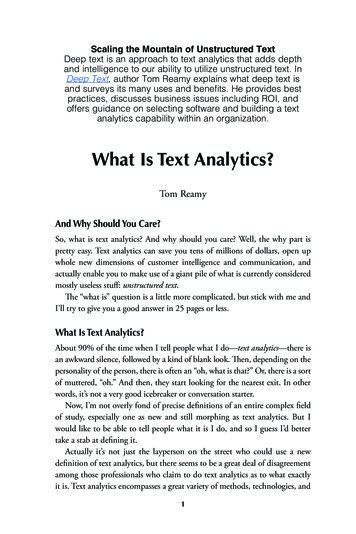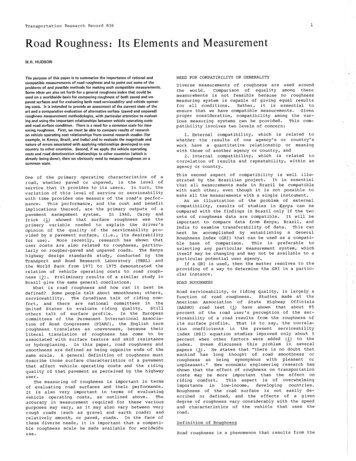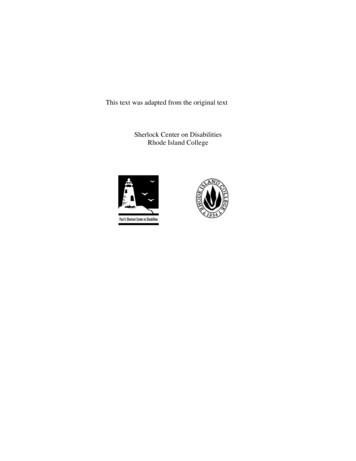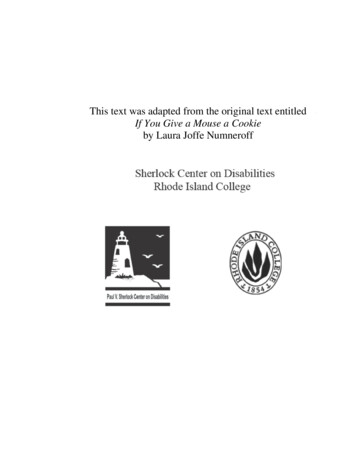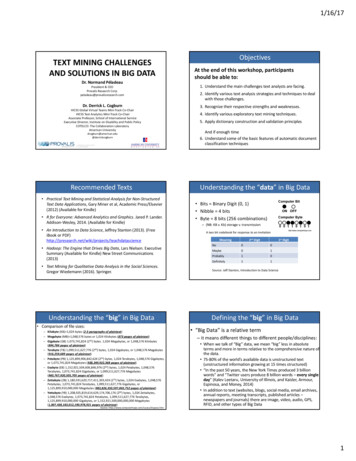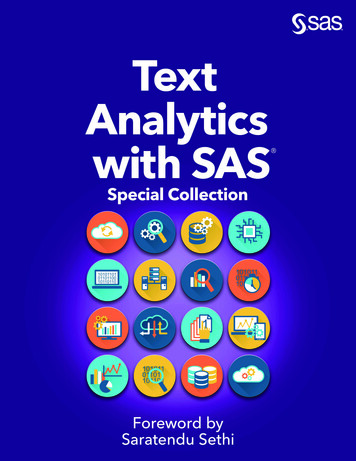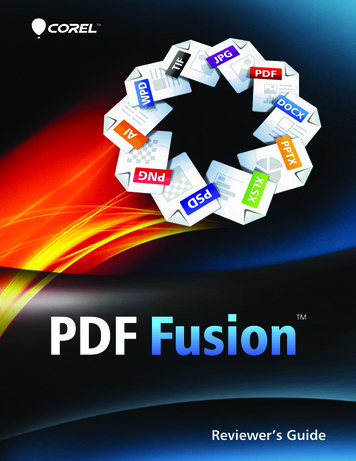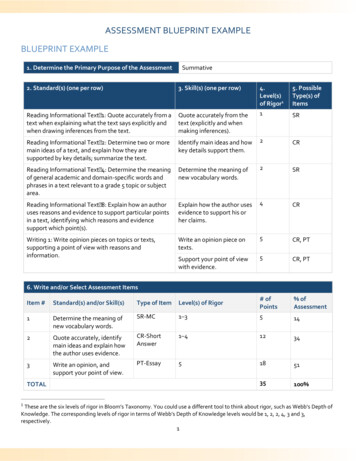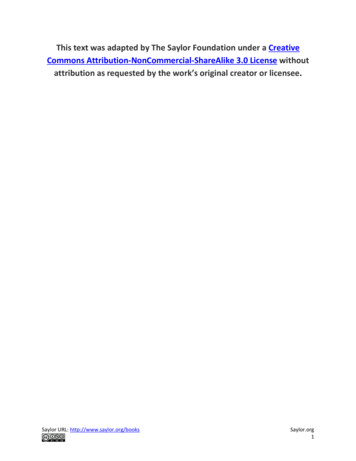
Transcription
This text was adapted by The Saylor Foundation under a CreativeCommons Attribution-NonCommercial-ShareAlike 3.0 License withoutattribution as requested by the work’s original creator or licensee.Saylor URL: http://www.saylor.org/booksSaylor.org1
PrefaceThe Sustainable Business Case Book provides readers with a broad overview of the core concepts ofsustainability and sustainable business practice. It is intended for use in undergraduate businesscourses and will also be of interest to students in environmental studies, engineering, urbanplanning, and government. This book is not meant to exhort all business people on the path tosustainability enlightenment but to highlight some of the benefits, opportunities, and challengesassociated with sustainable business practices.What distinguishes this book is that it provides a conceptual foundation to promote understanding ofsustainability concepts and frameworks and also discusses real-world business examples ofsustainability in action. It is believed that this is the best way to teach sustainability as it applies tothe business world—a conceptual foundation with practical application.Sustainable business involves businesses operating with interest and concern for their long-termeconomic, environmental, and social impact. For-profit businesses focus first and foremost on theirown economic bottom line, oftentimes, with a short-term perspective. However, with a sustainabilityperspective, businesses also consider a longer-term and broader triple bottom line that takes intoaccount not only company profits but also environmental and social impacts. The economic,environmental, and social perspectives are increasingly interrelated and relevant for businesses.OrganizationThis book combines foundation knowledge about sustainable business with detailed studies of businessesinvolved in sustainability practices. The first part (Chapter 1 "Introduction to Sustainable Business andSustainable Business Core Concepts and Frameworks" to Chapter 6 "Sustainable Business Marketing")introduces students to sustainability and sustainable business and presents key concepts, analyticalframeworks, and contextual information. Part two of the book (Chapter 7 "Case: Sustainable BusinessEntrepreneurship: Simply Green Biofuels" to Chapter 13 "Case: Strategic Mission–Driven SustainableBusiness: Stonyfield Yogurt") provides seven business case studies. These company cases illuminatesustainability principles and practices across business functional areas, including operation management,accounting, finance, marketing, entrepreneurship, and strategy. Each case chapter includes a descriptionof the business context, the motivating interest in business sustainability, and the sustainable businesspractices used. The discussion of sustainable business practice includes details on the practices, how theySaylor URL: http://www.saylor.org/booksSaylor.org2
were established, and their results. Each case chapter ends with a discussion of future considerations forthe company in its sustainable business efforts and exercises for students. All the chapters in the bookinclude learning objectives, key takeaways, key terms, and exercises. All the chapter sections, except forthe shorter case chapters, also include these. All the individual chapters in part two can be usedindependently as “stand-alone” case studies. The chapters will be relevant for general business, operationmanagement, entrepreneurship, accounting, and finance courses as well as in science and engineeringcourses, introducing students to business applications.Uncertainty in both the business and natural environments makes sustainability a valuable lens for thebusiness practitioner to navigate the future waters of our continually evolving world. We hope that youenjoy the journey ahead in this exciting and pragmatic approach to business thinking.Saylor URL: http://www.saylor.org/booksSaylor.org3
Chapter 1Introduction to Sustainable Business and SustainableBusiness Core Concepts and FrameworksGoogle Invests 39 Million in Wind FarmsIn 2010, Google invested 38.8 million in two North Dakota wind farms built by NextEra EnergyResources. These wind farms generate 169.5 MW of electricity, enough to power 55,000 homes. Google’sinvestment represents a minority interest in the 190 million financing of the projects. The two windfarms had already been built, but Google said that its investment would provide funds for NextEra toinvest in additional renewable energy projects. Google’s investment is structured as a “tax equityinvestment” where it will earn a return based on tax credits—a direct offset of federal taxes that Googlewould otherwise need to pay—for renewable energy projects, Google spokesman Jamie Yood said theenergy from the wind farms would not be used to power Google’s data centers, which consume largeamounts of electricity. Mr. Yood said that Google’s primary goal was to earn a return from its investmentbut that the company also is looking to accelerate the deployment of renewable energy. Renewable energycomes from sources such as solar panels and wind turbines to generate energy as opposed to othersources used such as coal or oil. Renewable energy typically has a much lower impact on the environmentdepending on the type and often emits little to no pollution.Conscious of its high electricity bills and its impact on the environment, Google has long had an interest inrenewable energy. Renewable energy projects at Google range from a large solar power installation on itscampus, to the promotion of plug-in hybrids, to investments in renewable energy start-up companies likeeSolar. Google has also worked on making its data centers more energy efficient, consume less electricitywhile still handling the same amount of data requests, and has developed technologies to let peoplemonitor their home energy use. But as of 2010, the company had yet to live up to its promise to help tofinance the generation of renewable energy. “We’re aiming to accelerate the deployment of renewableenergy—in a way that makes good business sense, too,” Rick Needham, green business operationsmanager at Google, wrote on the company’s blog.Source: Miguel Helft, “Google Invests 39 Million in Wind Farms,” New York Times, May 3, 2010.1.1 IntroductionSaylor URL: http://www.saylor.org/booksSaylor.org4
LEARNING OBJECTIVES1.Understand that businesses are increasingly acting with concern for the environment and society.2.Comprehend that business can play a positive role in helping to solve the world’s environmental andsocial problems.3.Appreciate that business interest in sustainability has been motivated by profit-making opportunitiesassociated with sustainable business practices.4.Understand that this book focuses on sustainable business case studies in the United States.Why would Google invest in wind farms that will not provide any energy for its high-energyconsuming data centers? Founded in 1998, Google runs the world’s most popular Internet searchengine. It’s a position that has earned Google high profits and has given it huge influence over theonline world. Then why would it take a risky investment of millions of dollars on an activity outsideits core business? And why would the US government provide tax credits to Google and other privatecompanies to invest in renewable energy? Can’t the private market and profit-making interests ofprivate businesses ensure that an adequate supply of renewable energy is produced in the UnitedStates and globally?All businesses, including Google, must focus on their economic performance and ensure they areprofitable and provide an attractive return on investment for their owners and investors. Withoutthis, businesses cannot continue as ongoing entities. For Google and other companies, their mostimportant “bottom line” is their own economic bottom line, which is their profitability, or revenue,minus expenses.Yet it is clear from Google’s investment in wind farms and the activities of private companies allaround the globe that many of today’s business leaders look beyond their own annual economicbottom line and act with concern for how their business activities affect the environment and thevery existence and sustainability of the world’s physical and human resources and capabilities. This iswhat this book is about.All companies must operate legally and achieve profitability to continue as ongoing entities. Allcompanies also embed and reflect in their decision making and activities the values and priorities oftheir owners, key managers, employees, and other stakeholders. As will be highlighted in this book,some companies, such as BP prior to the Gulf oil spill in 2010, focus on annual profitability andSaylor URL: http://www.saylor.org/booksSaylor.org5
investment returns to owners more than others. Other companies, including Google, give priority toother values (besides profit making) and take into consideration environmental and sustainabilityconcerns along with concern for annual profits. And other firms, such as Green Mountain CoffeeRoasters, Oakhurst Dairy, Simply Green, Timberland, Pax World, Seventh Generation, andStonyfield Farms (as described in Chapter 7 "Case: Sustainable Business Entrepreneurship: SimplyGreen Biofuels" through Chapter 13 "Case: Strategic Mission–Driven Sustainable Business:Stonyfield Yogurt" in this textbook), more fully integrate sustainable business practices into theirmission and corporate strategy and try to gain a competitive advantage by doing this.This book describes what it means for a business to be sustainable and to engage in sustainablebusiness practices and why a business would choose to act in a more sustainable manner. The bookwill be of interest to students who are interested in understanding the role of sustainable businessesin the economy and society, in addressing environmental concerns, and in working for or startingtheir own sustainable businesses.The focus of the book is on the experience, opportunities, and challenges for sustainable businessesin the United States. While the book does not provide detailed international examples in its in-depthcase chapters (Chapter 7 "Case: Sustainable Business Entrepreneurship: Simply Green Biofuels"through Chapter 13 "Case: Strategic Mission–Driven Sustainable Business: Stonyfield Yogurt"), itdoes discuss the opportunities and challenges of US-based sustainable businesses operating globally,specifically in Chapter 5 "Entrepreneurship, Innovation, and Sustainable Business" and Chapter 13"Case: Strategic Mission–Driven Sustainable Business: Stonyfield Yogurt". The objective is to exposestudents in the fields of business, science, public policy, and others to the ideals, opportunities, andchallenges of sustainable business practices with examples and lessons from a diverse group ofcompanies in different industries.SidebarWhat Is Sustainability?Sustainability is meeting “the needs of the present without compromising the ability of future generationsto meet their own needs.” This is a commonly referenced definition, developed by the Norwegian primeminister Gro Harlem Brundtland for the 1987 report “Our Common Future,” produced by the WorldCommission on Environment and Development under the direction of the United Nations.Saylor URL: http://www.saylor.org/booksSaylor.org6
SidebarWhat Does It Mean to Be Green and Is That the Same as Sustainable?And what does “green” mean and how does it relate to sustainability? Green is a term widely used todescribe buildings, products (of all types, including cars, food, computers, etc.), and services designed,manufactured, or constructed with minimal negative impact on the environment and with an emphasis onconservation of resources, energy efficiency, and product safety. Being “green” can help to preserve andsustain society’s resources.KEY TAKEAWAYS Businesses are increasingly engaging in activities with concern for the environment and society. Businesses are engaging in these activities because they recognize they can play a positive role inhelping to solve the world’s environmental and social problems.Businesses are also interested in sustainability because of market and profit-making opportunities associated with sustainable business practices.This book intends to explore the opportunities and challenges for sustainable business in the United States primarily through case studies.EXERCISES1.a.Answer the following questions:Do you think that Google would have invested in the two North Dakota wind energy projects if theydid not receive tax credits (a government incentive that reduces the federal taxes that they owe)? Whyor why not?b.Besides tax credits, what are some of the other benefits that Google could obtain by investing in thewind energy projects?c.Based on this article, do you think that it is wise for Google to continue investing in potential futurerenewable energy projects given that their core successful business model is based on web searchesand not providing energy?Saylor URL: http://www.saylor.org/booksSaylor.org7
Search on the web and find three other examples of companies investing in renewable energyprojects, even though those companies’ core business models do not involve energy production.Describe the business, their core business model, and the type of project they invested in.1.2 Overview of Sustainable BusinessLEARNING OBJECTIVES1.Explain what it means to be a sustainable business and the relationship of profitability andsustainability.2.Understand what is meant by the triple bottom line for businesses in relation to sustainability.3.Describe what is meant by enlightened self-interest and provide an example of how it applies tobusiness.A focus on sustainability (for private businesses) can be thought of as a management strategy thathelps businesses set goals and prioritize resource allocations. Sustainability at the private businesslevel can first be thought of primarily in terms of financial sustainability—that is, the ability ofprivate firms to generate profits and cash flow to sustain business operations. For-profit businesses—first and foremost—must focus on their economic bottom line. A company that earns a profit isproviding a good or service that is valued by society. Consumers and businesses do not pay forproducts and services that do not provide them with value or benefits above the cost of the productor service to them (or else they would not have made the free decision to purchase that product orservice). Therefore, at a basic level, if a business is profitable, it is having a net positive social impact.This is assuming that the business has no external impact on the environment or society.However, there are companies that are profitable in the short term that are having a long-term netnegative impact. For example, a lumber company that owns timber reserves could harvest all of itstimber resources in one year generating a significant profit for that one year. However, if in doingthis the company ignored the costs and losses associated with destroying the forest and the ability ofthe forest to continue to produce timber, then the net impact could be negative. By depleting theresource base of the company, short-term gain can lead to long-term financial failure for thecompany. This example highlights the need for sustainable thinking in business. For business to beSaylor URL: http://www.saylor.org/booksSaylor.org8
sustainable in a financial sense, businesses must increasingly consider the longer term and broaderconsequences of decisions.Beyond just the company’s own bottom line, a “next step” for businesses is to consider not only theirown long-term financial performance but also broader societal environmental and social impacts.This so-called triple bottom line(TBL) considers business from economic, environmental, and socialperspectives and measures business performance based on net impact on profit, people, and planet.This approach to business will be increasingly relevant to students of business and in other fields asglobal populations and demand for energy, water, and other resources increase and our planet facesresource shortages. Over the next fifty years, the world’s population is expected to grow from 6.8billion to 9.5 billion, and the demand for energy and other resources will follow.The primary aspects of sustainability considered in this book are profit and planet. Much of theframework and concepts relevant for environmental sustainability also apply to social sustainabilityand several of the case study chapters highlight examples of businesses, such as Seventh Generation,Green Mountain Coffee Roasters, Stonyfield, and Simply Green, incorporating social issues into theirdecision making.For businesses that consider TBL and sustainable business practices, it is increasingly not aboutdeciding whether to focus on (earning) profits, or (saving) the planet, or (caring about) people.Instead, it’s about focusing on all three. When McDonald’s reduces the packaging with their food,they help the environment, contribute to public health (by reducing toxics in the atmosphere), andthey also help their economic bottom line. Enlightened self-interest occurs when companies (orindividuals) help others and, in the process, help themselves. When McDonald’s uses less packagingfor their hamburgers, French fries, and other food items than in the past, this reduces their costs ofmaterials and disposal costs while at the same time it helps the environment. Reducing packaging isan example of a sustainable business practice that can benefit a private company and also society atlarge.In the longer term, all businesses rely on the sustainability of societies’ resources, including energy,food, and material resources, for their success and survival. Thus it can be in all businesses longterm interest to act with concern for the sustainability of society’s resources.SidebarSaylor URL: http://www.saylor.org/booksSaylor.org9
Doing Well and Doing GoodCompanies that act with enlightened self-interest are also commonly referred to as doing well (forthemselves) at the same time that they are doing good (good things for others), or “doing well by doinggood.”The linked image cannot be displayed. The file may have been moved, renamed, or deleted. Verify that the link points to the correct file and location.Source: K food MacDonalds set lunch potato July2011.jpg.Gulf Oil Spill[1]The 2010 Gulf of Mexico oil spill—the disaster that quickly became the largest oil spill in US history —offers a vivid example of how sustainability issues affect profits, people, and planet. The spill (as of June2010) was estimated to have leaked at least triple the amount of oil as compared to the Exxon Valdez spillin Alaska during 1989.BP put itself into a very difficult and controversial position. BP had a history of accidents that wereharbingers of the Gulf spill, including having to pay 25 million in fines for a spill on the north shore ofAlaska in 2006. Then in 2010 under financial and time pressure, BP failed to properly cap it’s Gulf Coastwell from which they had been drilling. BP hastened through procedures to detect excess gas in the well,skipped quality tests of the cement structure around the pipe, and even assigned an inexperienced[2]manager to oversee final well tests. While most of the company’s actions were not best practices, theywere within acceptable industry standards and believed by many to be legal. The oil released from theuncapped well threatened the valued ecosystem of the Gulf in very serious ways. The oil adverselySaylor URL: http://www.saylor.org/booksSaylor.org10
impacted populations of fish, marine birds, and other aquatic wildlife and threatened fragile wetlandecosystems.BP could have at some short-term cost avoided the Gulf oil spill. Instead, the company chose not to put inplace some safety features and then delayed responding to signals that there were problems in thepipeline, which resulted in a major pipeline break with catastrophic implications for the environment andsignificant economic costs to the company. From when the drilling rig exploded on April 20 through June2, 2010, the company lost a third of its market value, or about 75 billion, and the company had spentalmost 1 billion on cleanup efforts. One analyst calculated that in a worst-case scenario, BP’s cleanupliability would be around 14 billion, which would account for the entire loss of all fishing and tourismrevenues for coastal states closest to the spill.[3]The linked image cannot be displayed. The file may have been moved, renamed, or deleted. Verify that the link points to the correct file and location.The BP Gulf of Mexico situation highlights why sustainable business is of increasing interest andimportance to students of business and also students in science, government, public policy,planning, and other fields.Source: P Oil spill Chandeleur IslandsLA.jpg.KEY TAKEAWAYS Sustainable business involves making decisions and taking actions that consider the long-term impactof the business on society and the environment while still maintaining profitability. People, planet, and profit—also known as the triple bottom line—are the three areas that businessesinterested in sustainability measure their impacts. This varies from traditional businesses, which arepredominantly focused on profits as their measure of success.Saylor URL: http://www.saylor.org/booksSaylor.org11
Enlightened self-interest refers to business as taking actions that are good for the environment and society but that also help make the business better off.The Gulf oil spill provides an example of how acting in an unsustainable manner with a short-term focus on profit can have significant long-term negative impact for society, the environment, and theeconomy—including BP, which was seeking to maximize its profit.EXERCISES1.Search the web for an article that discusses an action that a company took that benefited theenvironment or others outside of the company and that also had a financial benefit for the company. Beprepared to discuss what the action was, the financial benefit the company achieved by taking action, andhow that action led to the financial benefit.2.Some have argued that the purpose of a business is to earn a profit and that is its only goal. Do youagree with that? Discuss what you feel are some pros and cons of a business expanding its focus toconsider the effect of its actions on “people” and “planet.”[1] “Estimates Suggest Spill Is Biggest in U.S. History,” New York Times, May 28, tml?ref us.[2] “BP Decisions Set Stage for Disaster,” Wall Street Journal, May 27, 8704026204575266560930780190.html?KEYWORDS It was a difficult drill from the start.[3] Jad Mouawad and John Schwartz, “Cleanup Costs and Lawsuits Rattle BP’s Investors,” New York Times, June 1,2010.1.3 What Does It Mean to Be a Sustainable Business?LEARNING OBJECTIVES1.Identify what it means to be a sustainable business.2.Define what constitutes sustainable business practices and provide examples.3.Describe the main motivations for engagement in sustainable business practices.4.Discuss the barriers that businesses can encounter in adopting sustainable business practices.Saylor URL: http://www.saylor.org/booksSaylor.org12
The sustainable business perspective takes into account not only profits and returns on investmentbut also how business operations affect the environment, natural resources, and future generations.Sustainability at the business level can be thought of as taking steps, such as recycling andconserving nonrenewable material and energy use to reduce the negative impact of a business’soperations on the environment. While managing operations to reduce negative environmentalimpact is an important part of business sustainability, these types of activities are increasingly part ofa deeper strategic perspective on sustainability for businesses.Businesses implement sustainability in their organization for a variety of reasons. The benefits frompursuing sustainability can include the following: Reduction of energy and materials use and waste and the costs associated with these. McDonald’sreducing the packaging with hamburgers and French fries is an example of this. Lowering of legal risks and insurance costs. For example, BP, with some investment in safetyfeatures to protect against environmental disaster, could have avoided huge liability costs that will beassociated with Gulf of Mexico oil spill. Differentiation of product or services and brand. Companies such as Green Mountain CoffeeRoasters (see Chapter 9 "Case: Brewing a Better World: Sustainable Supply Chain Management atGreen Mountain Coffee Roasters, Inc.") and Stonyfield Farm (see Chapter 13 "Case: StrategicMission–Driven Sustainable Business: Stonyfield Yogurt") have differentiated their brands andincreased consumer awareness and sales of products with their focus on sustainability. Drive toward innovation to create new products and serve new markets. Seventh Generation(see Chapter 8 "Case: Marketing Sustainability: Seventh Generation Creating a Green HouseholdConsumer Product") developed new products to address environmental concerns of households andpositioned themselves as the leader in that market, sustainable consumer household products. Improvement of company image and reputation with consumers, particularly the increasingnumbers of consumers who are concerned about the environment and their own impact on theenvironment (see Chapter 6 "Sustainable Business Marketing" for more discussion of consumerpreferences for sustainable products and services). Enhancement of investor interest. Increasing numbers of investors take into considerationcompany sustainability practices when they make their decisions how to invest (see Chapter 12 "Case:Saylor URL: http://www.saylor.org/booksSaylor.org13
Sustainable Investing: Pax World Helping Investors Change the World"). Companies that act withconcern for social and environmental matters operate at lower risk and their future growth rates canbe positively affected. Both of these are positive factors for investors. Increase attraction and retention of employees who care about the environment andsustainability.The most important factors that motivate companies to become more sustainable are internal. Thisincludes the number one objective of companies—to maximize profits. The beliefs and personalvalues of management and employees can also significantly influence engagement in sustainablebusiness practices. Many managers and employees have an interest in sustainability and its benefitsto society. They can move the company forward on sustainable business practices because it’s theright thing to do—that is, owners, managers, and employees believe that sustainable businesspractices are the moral and ethically right thing to do. Companies with senior management andowners who are committed to sustainable business practices for ethical reasons are more likely toput in place sustainable business practices even without having a detailed assessment of how it willaffect revenue, costs, and profitability.There are also important external factors that influence a business’s decision to become moresustainable, including governmental laws and regulations and consumer and investor interests andexpectations. These external factors are strongly influenced by societal trends and values,demographics, new knowledge (including scientific findings, highlighted in Chapter 2 "The Scienceof Sustainability"), and the media.Sustainable businesses strive to maximize their net social contribution by embracing theopportunities and managing the risks that result from an organization’s economic, environmental,and social impacts. In many respects, the best measure of business contributions to society areprofits. Profits represent the value of products and services that companies provide (as reflected inthe prices that consumers are willing to pay for a company’s products and services) minus the directcosts of producing the products or services.However, private market transactions do not take into account so-called external costs to markettransactions. For example, the external costs associated with the production of electricity from coalinclude climate change damage costs associated with the emissions of carbon dioxide (CO2) andSaylor URL: http://www.saylor.org/booksSaylor.org14
damage costs (such as impacts on health, crops, etc.) associated with other air pollutants (such asnitrous oxide and sulfur dioxide). These pollutants threaten the future sustainability of naturalresources and have a cost, and these costs are not included in the price of energy and not passed onto consumers. Thus market prices do not reflect costs to society perfectly, and this can result insignificant differences between profits and the net societal contributions of companies and canpresent challenges to businesses interested in maximizing their net positive social impact and actingin a sustainable way. Government often acts to address market failure and to reduce the externalcosts associated with pollution and environmental damage incurred in market activities. Controllingnegative externalities is used to justify government restrictions, regulations, taxes, and fees imposedon businesses (see detailed discussion in Chapter 3 "Government, Public Policy, and SustainableBusiness"). Governments at the federal, state, and local level in the United States have acted on this.In general, European nations have been more active in trying to address market failures and trying tocontrol external costs associated with market activities in environmental, social, and other arenasthan the United States.SidebarThe Role of Government Policies in Sus
Each case chapter ends with a discussion of future considerations for the company in its sustainable business efforts and exercises for students. All the chapters in the book include learning objectives, key takeaways, key terms, and exercises. All the chapter sections, except for the sh

